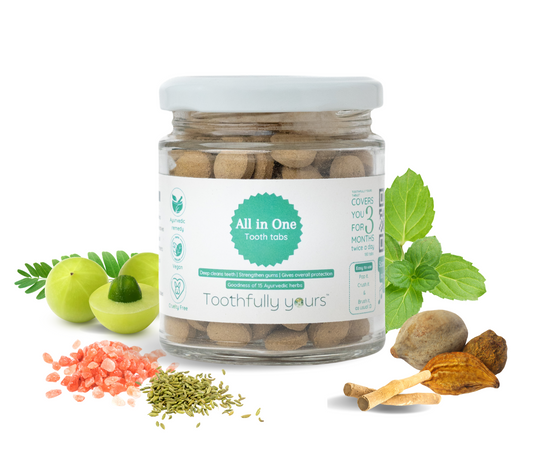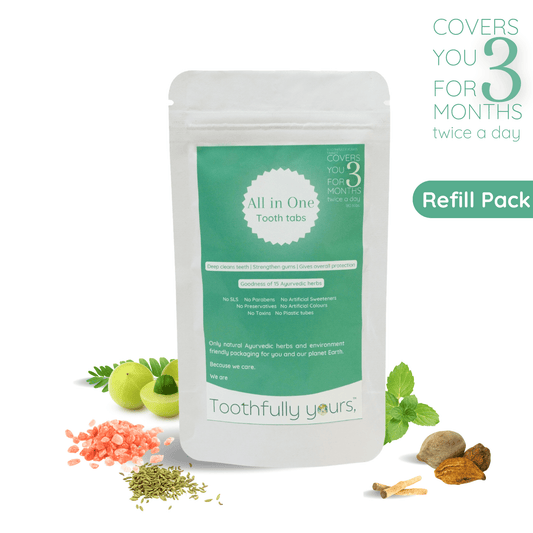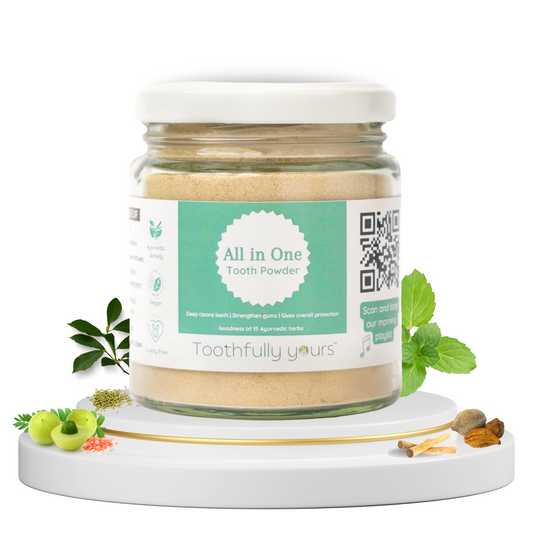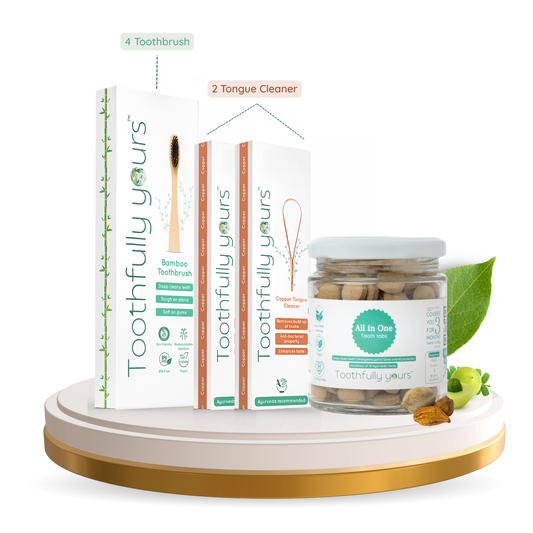
Oil Pulling: Myths vs. Facts
In the age of quick-fix oral hygiene products and flashy ads of alcohol based mouthwashes, there’s one ancient practice that quietly continues to earn its place in modern wellness routines: oil pulling. Rooted in Ayurvedic oral care, oil pulling is the simple act of swishing sesame oil medicated with herbs in the mouth—and yet, it’s wrapped in layers of skepticism, myths, and misinformation.
Is oil pulling really a cure-all? Or is it just another wellness fad that’s overstated?
In this blog, we separate the myths from the facts and take a deep dive into what oil pulling is, what science says about it, and how to do it correctly for real oral health benefits.
Is Oil Pulling a Miracle Cure? Myths vs. Facts
Originating from the ancient Ayurvedic oil pulling is practiced in two styles- Kavala and Gandusha. Gandusha involves keeping your mouth full of oil until your eyes become watery. In Kavala, it involves swishing a tablespoon of oil—typically sesame or coconut oil—in your mouth for 10–20 minutes on an empty stomach until the oil becomes watery.
The idea is simple: as you swish, the oil "pulls" toxins and bacteria from the oral tissues, helping to detoxify the mouth, improve gum health, and balance oral microbiota.
But in recent years, oil pulling has become the subject of wild claims—everything from curing acne to reversing diabetes. This has, unfortunately, clouded the real, evidence-backed benefits of oil pulling for oral care.
Let’s clear the air.
Also Read: What is Oil Pulling? All You Need to Know
Top Myths About Oil Pulling – Debunked
Myth 1: Oil pulling is a replacement for brushing and flossing
Fact: Oil pulling is complementary, not a replacement.
Yes, it helps reduce bacteria and supports gum health—but it doesn't remove plaque as effectively as brushing and doesn’t clean between teeth like flossing. For complete oral hygiene, continue brushing and flossing daily and add oil pulling as a powerful first step in your morning routine.
Myth 2: Oil pulling whitens teeth instantly
Fact: Oil pulling can help remove surface stains, but it's not a bleaching treatment.
Over time, oil pulling may gradually brighten your smile by reducing plaque and pigmentation caused by food or drinks. However, don’t expect movie-star white teeth overnight, as it has no harsh bleaching agents. The sesame oil only helps your to get back your original colour, which could have be stained due to lifestyle. Think of it as a natural polish, not a bleach.
Myth 3: Any oil will work for oil pulling
Fact: Not all oils are created equal.
Ayurveda recommends sesame oil as the traditional choice for its antimicrobial and balancing properties. Coconut oil is also widely used but the cold pressed oil and not your regular hair oil. Coconut oil is especially used for its lauric acid content, which has antibacterial effects. Avoid refined oils, hair oils or synthetic blends, as they may do more harm than good.
Myth 4: Oil pulling cures systemic diseases like diabetes and asthma
Fact: No scientific evidence supports this claim.
While oil pulling is a powerful detox practice that may reduce the body’s inflammatory load, it is not a cure for systemic conditions. Relying solely on oil pulling for chronic diseases is not just ineffective—it’s unsafe. Always consult a medical professional for systemic issues.
Oil pulling is a great practice to save your from diseased associated with your oral cavity.
Myth 5: You have to swish for 20 minutes or it won’t work
Fact: To beginners, Even 5–10 minutes can provide benefits.
While traditional texts mention 15–20 minutes, but due to fast life you can start with 5–10 minutes to start benefiting from the practice. It will start the process of disrupting bacterial colonies and cleansing the mouth. The key is consistency.
Backed by Science – What Oil Pulling Can Actually Do
Here’s what modern research and Ayurvedic wisdom agree upon when it comes to oil pulling for oral care:
✅ Reduces Harmful Bacteria in the Mouth
Studies show oil pulling can significantly reduce Streptococcus mutans, one of the main bacteria responsible for tooth decay. It also helps manage candida and other fungal overgrowths in the oral cavity.
✅ Supports Gum Health
Oil pulling increases circulation in the gums and helps reduce inflammation, making it especially useful for bleeding gums, gingivitis, and sensitive teeth.
This is why oil pulling for healthy gums is a cornerstone in Ayurvedic oral care routines.
✅ Prevents Bad Breath (Halitosis)
By reducing sulfur-producing bacteria, oil pulling can help neutralize bad breath and leave your mouth feeling fresh—without the sting of alcohol-based mouthwash.
✅ Promotes Overall Detoxification
While the primary benefits are local (oral), Ayurveda believes the mouth is a gateway to the body. Regular oil pulling helps eliminate ama (toxins), potentially reducing the body’s inflammatory burden.
✅ Reduces Plaque Formation
By creating a slick surface, oil makes it harder for plaque to stick and accumulate—making it a helpful preventive measure in daily oral care.
Expert Tips for Safe & Effective Oil Pulling
Want to get the most out of oil pulling? Here’s how to do it the right way:
🥄 Choose the Right Oil
-
Sesame oil: Traditional Ayurvedic choice—warming and balancing for all doshas.
-
Coconut oil: Cooling, antimicrobial, and widely available.
- Avoid refined, flavored, or cooking oils.
⏰ When to Do It
-
First thing in the morning, before brushing, drinking, or eating
-
On an empty stomach for maximum effect
🌀 How to Oil Pull
-
Take 1 tablespoon of oil.
-
Swish it gently around your mouth—don’t gargle or swallow.
-
Try to pull it between your teeth and cheeks.
-
Spit it out into a trash bin (not the sink—it can clog drains).
-
Rinse your mouth with warm water.
-
Follow with your regular brushing and tongue cleaning.
Start with 5–10 minutes and gradually build up if needed.
🚫 Don’t Make These Mistakes
-
Don’t swallow the oil—it contains toxins and bacteria.
-
Don’t swish aggressively—it can cause jaw soreness.
-
Don’t skip brushing—oil pulling is not a substitute.
Conclusion: A Small Ritual with Big Results
In a world that celebrates high-tech solutions and synthetic quick fixes, it’s refreshing to rediscover a simple, ancient practice like oil pulling. It's not magic. It’s not a miracle cure. But it is a powerful, holistic addition to your oral care routine, rooted in centuries of Ayurvedic wisdom.
For anyone embracing a cleaner, more mindful lifestyle, oil pulling is a perfect first step each morning—a ritual that reconnects you to your body, your breath, and your health.
No harmful chemicals. No alcohol based liquid. Just highly effective herbs medicated in oil, intention, and time.
FAQs
Is oil pulling safe for children?
Oil pulling is generally not recommended for kids under 5, as they may accidentally swallow the oil. For older children, start with a teaspoon and supervise the process.
How often should I oil pull?
Daily is ideal, especially in the morning. But even 3–4 times a week can offer benefits.
Can I use essential oils in my pulling oil?
Yes—but be cautious. If you’re using essential oils like clove or peppermint, make sure they’re food-grade and use only 1–2 drops per tablespoon of base oil.
Will oil pulling whiten my teeth?
It may gradually remove surface stains and make your teeth appear cleaner and brighter, but it won’t bleach enamel like chemical whiteners.
Can I do oil pulling if I have dental work like fillings or crowns?
Yes. Just ensure you’re using gentle motions and not swishing too aggressively.





